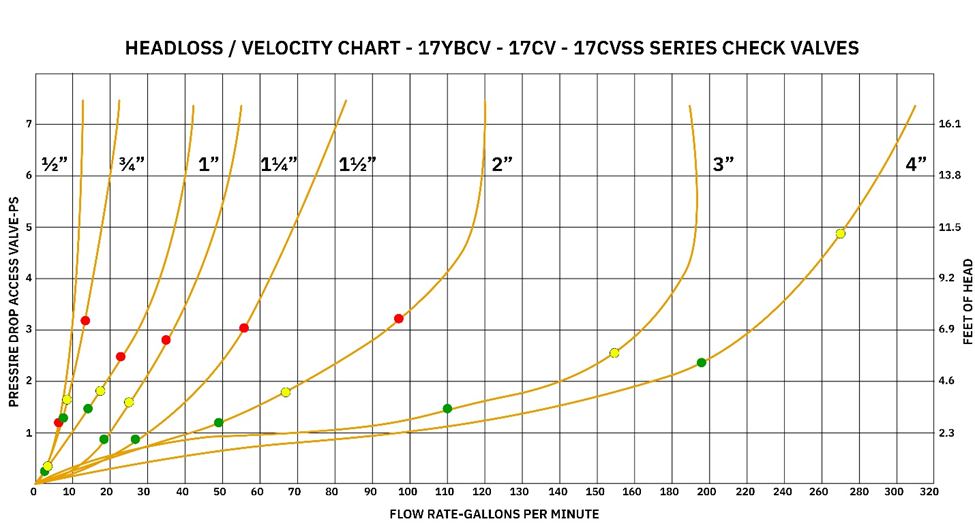When dealing with check valves, have you came across a term that you didn't understand or know what it is referring to? Some terminology referring to check valves are presented as symbols, making it difficult to confirm what each symbol is attributing to.
In this blog, we have created a guide that includes the variety of terms you will come across when  dealing with check valves, specifically the 17YBCV series, the 17CV series and the 17CVSS series. We will also touch on what flow coefficient is and how to determine it.
dealing with check valves, specifically the 17YBCV series, the 17CV series and the 17CVSS series. We will also touch on what flow coefficient is and how to determine it.
For information about Check & Foot valves, check out our blog Taking a Look at Check and Foot Valves.
Valve Terminology
Specific Gravity (SG):
Specific gravity is the ratio of any fluids weight compared to the weight of water at 62°F (16°C). For an example, water has a specific gravity of 1.00 as it is a ratio of itself. More dense fluids would have a higher ratio, similarly less dense fluid would have a low ratio.
Cracking Pressure:
The cracking pressure is the pressure that a component starts to open. This term solely references our check valves, When the 1/2 PSI cracking pressure is reached, the check valve will start to open.
Rate of Flow (Q):
Rate of flow (Q), is the variable that represents the amount of fluid that is passing through the valve at any given time, usually represented in GPM. In order to properly calculate the rate of flow, you will need to know the volume (V) and the time (T) it takes the volume to pass through.
Velocity (V):
Another important thing to take into consideration when you are selecting a valve is flow velocity. Larger pipe is more expensive but keeping the water velocity low is important to limit the pressure lose that happens from friction and water hammer. It is recommended that you size your pipe according to a water velocity of 5 ft/second (1.524 LPM). The threshold of five feet per second is widely accepted by engineers. This is because beyond the velocity, the friction losses, the danger of water hammer and the pipe movement due to water momentum changes are deemed too high.

Head Loss:
The reduction in the total head, sum of elevation head, velocity head and pressure head of the fluid as it moves through a fluid system is the act of head loss. The chart above provides the head loss data for the three series of valves mentioned above. When the flow velocity is maintained, the head loss across the valves is typically 1.5 PSI or less, except for the 4" valves at approximately 2.3 PSI.
Pressure Drop (P):
Pressure drop (P) is a complex variable to calculate so it is recommended that you use a chart to figure out the pressure drops for the specific types of pipe. Without using a chart, you will need to figure out the friction coefficient of the pipe, the hydraulic diameter, the pipe length, the density of the fluid and finally, the flow rate.
What is Flow Coefficient?
Flow coefficient (CV) refers to the number of U.S gallons that can pass through a fully opened valve at a pressure drop of 1 PSI. You can test this by running water (specific gravity of 1.0 centistoke viscosity) at 60°F (15°C), unless stated otherwise.
The chart below provides the flow coefficient for our 17YBCV series, 17CV series and 17CVSS series check valves.

The flow coefficient is used to properly size the valves to ensure they have a minimal effect on the hydraulic efficiency of your system. Knowing the flow coefficient is one of the most important aspects you need when you are selecting the right size of valve. For an example, a 1-1/4" valve that has a flow coefficient of 20.1, has an effective port area in the fully open position, meaning that it is capable of passing 20.1 GPM of water with a pressure drop of 1 PSI.
In Conclusion:
The charts are the easiest and most practical pieces of information to use when trying to determine the flow coefficient. Refer to this ultimate guide to match the symbols to the different terms that are used when using check valves.
Have further questions about this subject?

Head over to Boshart's Knowledge Base: technical product information, guidelines, and more.





SHARE